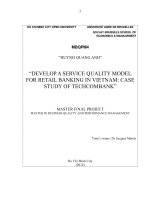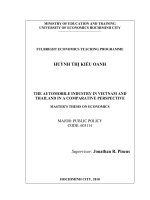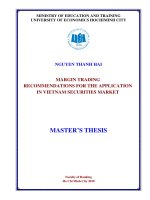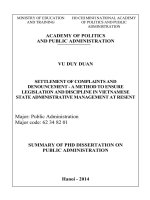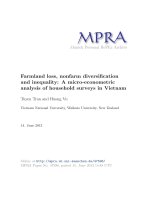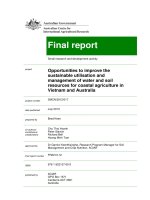Explore a winning sales approach for hospitality industry in vietnam
Bạn đang xem bản rút gọn của tài liệu. Xem và tải ngay bản đầy đủ của tài liệu tại đây (390.69 KB, 94 trang )
EXPLORE A WINNING SALES APPROACH FOR
HOSPITALITY INDUSTRY IN VIETNAM
MASTER OF BUSINESS ADMINISTRATION
In International Business
by
Mr Dang Minh Tri
ID: MBA 01042
International University - Vietnam National University HCMC
April 2013
i
EXPLORE A WINNING SALES APPROACH FOR
HOSPITALITY INDUSTRY IN VIETNAM
In Partial Fulfilment of the Requirements of the Degree of
MASTER OF BUSINESS ADMINISTRATION
Major at International Business
by
Mr Dang Minh Tri
ID: MBA01042
International University - Vietnam National University HCMC
April 2013
ii
Under the guidance and approval of the committee, and approved by all its
members, this thesis has been accepted in partial fulfilment of the
requirements for the degree.
Approved:
----------------------------------------------Chairperson
----------------------------------------------Committee member
-----------------------------------------------Committee member
-----------------------------------------
Committee member
-----------------------------------------
Committee member
----------------------------------------Committee member
iii
PLAGIARISM STATEMENTS
I would like to declare that, apart from the acknowledged references,
this thesis either does not use language, ideas, or other original material from
anyone; or has not been previously submitted to any other educational and
research programs or institutions. I fully understand that any writings in this
thesis contradicted to the above statement will automatically lead to the
rejection from the MBA program at the International University – Vietnam
National University Hochiminh City.
iv
COPYRIGHT STATEMENT
This copy of the thesis has been supplied on condition that anyone who
consults it is understood to recognize that its copyright rests with its author
and that no quotation from the thesis and no information derived from it may
be published without the author’s prior consent.
DANG MINH TRI – MBA 01042- YEAR 2013
v
TABLE OF CONTENT
List of tables
xi
List of figures
xiii
Abstract
xiv
Chapter One – Introduction
1
1.1. Reasons to choose the topic
1
1.2. Introduction of B2B and Hospitality industry
2
1.2.1. Business-to- Business (B2B)
2
1.2.2. Hospitality projects
2
1.2.3. B2B Hospitality projects in Vietnam
3
1.2.4. Motivations to choose the topic
6
1. 3. Purposes of the research (research significance)
6
1. 4. Research questions
7
1. 5. Scope and Limitations
7
1. 6. Organization of the study
7
1.6.1. Chapter 1: Introduction
7
1.6.2. Chapter 2: Literature Review
7
1.6.3. Chapter 3: Research Methodology
7
vi
1.6.4. Chapter 4: Findings
8
1.6.5. Chapter 5: Conclusion and Recommendation
8
Chapter Two - Literature Review
9
2.1. Classification of B2B Groups
9
2.1.1. Users
9
2.1.2. Original Equipment Manufacturers (OEMs)
15
2.1.3. Middle Man
16
2.2. B2B Buying Situation
16
2.2.1. Straight Re- Buy
16
2.2.2. Modified Re-Buy
17
2.2.3. New Task
17
2.3. “Buying Centre”
18
2.3.1. Initiators
19
2.3.2. End Users
19
2.3.3. Influencers
19
2.3.4. Deciders
20
2.3.5. Approvers
20
2.3.6. Buyers
20
vii
2.3.7. Gate Keepers
2.4. Classification into “Buying Stages”
21
21
2.4.1. Stage 1: Problem Recognition
21
2.4.2. Stage 2: General need description
22
2.4.3. Stage 3: Product specification
22
2.4.4. Search for potential suppliers and evaluate
23
2.4.5. Proposal solicitation and analysis
23
2.4.6. Supplier evaluation and selection
23
2.4.7. Stage 7: Order- routine specification
23
2.4.8. Stage 8: Performance Review
24
2.5. Project Stages
25
2.5.1. Planning
25
2.5.2. Designing
25
2.5.3. Procuring and Constructing
26
2.5.4. Mocking-up room
27
2.6. Marketing Mix 4Ps
28
2.6.1. Products
28
viii
2.6.2. Price
28
2.6.3. Place
29
2.6.4. Promotion
29
2.7. Corruption
29
Chapter 3: Methodology
31
3.1. Research methods
31
3.1.1. Qualitative research
31
3.1.2. Quantitative research
32
3.2. Data collection
37
3.2.1. Select samples
37
3.2.2. Methods to collect data
37
3.3. Format questions
47
3.4. Data analysis
48
3.5. Validity and Reliability
52
Chapter 4: Findings
54
4.1. Findings about critical selling factors
54
4.2. Develop the practical approaching models
59
4.2.1. Findings of relationship between Users and Buying stages
59
ix
4.2.2. Findings of relationship between Users and Marketing mix
69
4.2.3. Findings of relationship between Buying stage and Marketing
mix 72
Chapter 5: Conclusion and Recommendation
75
5.1. Conclusion
75
5.2. Recommendation
76
5.3. Limitations
77
5.4. Further research
77
x
LIST OF TABLES
Table 1: The local and foreign visitors to Vietnam
considerably increased since 1990
4
Table 2: Foreign Direct Investment (FDI)
into the hospitality industry in Vietnam since 1995
Table 3: Some of construction material required for hospitality projects
4
6
Table 4: Well-known interior designers and architects attended
projects in Vietnam
12
Table 5: Global hospitality operators managing the projects in Vietnam
15
Table 6: Users attending in Novotel Saigon
15
Table 7: Qualitative versus Quantitative research
36
Table 8: Users who will attend the interviews
42
Table 9: Suppliers answering about commission
44
Table 10 and 11: Total interviews conducted for the research
45
Table 12: Dimension relationship between Users and Buying stages
50
Table 13: Dimension relationship between Marketing Mix and Users
51
Table 14: The relationship between Buying Stages and Users
52
Table 15: Cold calls are not an effective method
58
xi
Table 16: Perspective of approaching Marketing Mix
in the dimension between Users and Buying stages
60
Table 17: Considerable changes of ordering sanitary and fittings in the
hospitality projects managed by international operators 63
Table 18: Small changes of ordering sanitary and fittings in the hospitality
projects managed by local investors
63
Table 19: Specifications are changed much in the international hospitality
66
Table 20: Specifications are majorly kept for final installation
66
Table 21: Perspective of approaching Buying Stages
in the relationship between 4Ps and Users
69
Table 22: Perspective of approaching Users in the relationship
between 4Ps and Buying Stages
73
xii
LIST OF FIGURES
Figure 1: Hospitality industry- a branch of real estate
3
Figure 2: Roles of the Buying Centre (Kotler, 2006)
21
Figure 3: Eight buying stages of a project constructing
24
Figure 4: The power role of architects in a hospitality project management 26
Figure 5: Critical factors collected during the interviews
56
Figure 6: Models of international hospitality management
64
Figure 7: Model of local hospitality project management
64
xiii
ABSTRACT
Almost all of the owners always look for the suitable sales models to
enhance their business performance. Beside an experienced sales team, the
companies can win their competitors and grow dramatically if they succeed in
building methods of customer approaches. The research has helped the
companies to find this expectation.
The results of this research include 25 depth interviews from suppliers
and customers who are hospitality investors, contractors, designers and hotel
operators. Their contributions have brought many critical sales factors and
help to create 3 models of sales approaches. Salespeople can learn
methodologies and techniques to build the practical plans for their companies.
In conclusion, the research has supplied the trading companies or
suppliers with sales models. They will encourage salespeople to take right
actions and win the sales contracts.
xiv
CHAPTER 1: INTRODUCTION
In this chapter of thesis, the author would like to give a brief
introduction about the B2B hospitality activities in Vietnam. Some reasons,
problems and purposes which have led me to choose this topic will be
shared. Finally, a short background of the research introduces about the
history of topic development.
1.1. Reasons to choose the topic
“How to increase the sales performance” is always one of the tough
questions to most of the companies or organizations. Nowadays, so many
players have caused an extremely harsh marketplace. Customers always
have more than one alternative for their buying decisions. According to
Bundschuh and Dezvane (2003), products (understood for the same
segments) seem to become similar at functions, designs, quality. Therefore,
beside to financing marketing programs, the companies should look for
suitable ways to approach potential customers. And depending on types of
business, each company applies a different customer approach.
Actually, if B2C enterprises attract their customers by financing
marketing programs, organizing events and expanding distribution channels;
B2B companies of hospitality industry take care of their clients in accordance
with the construction stages of projects. Different from B2C which choosing a
product may only take some minutes, a buying decision of hospitality
investors can be finalized after some months or many years to work with
many people and solve many other factors.
According to Mr Nguyen Van Hai- sales director of Star Home
Appliances Company Limited, approaching the right people and right time
1
can bring his company more than 50% percentage of chance to win the deal.
Because the B2B sales can last long time, salespeople need to know the
working process. In fact, the overhasty contacts can interrupt the business
opportunity.
From the requirements of reality, the author would like to build the
process of customer approaches in B2B hospitality industry. Salespeople will
recognise the persons, the period, etc. to approach the projects. And the final
purpose helps organizations to increase the sales performance.
1.2. Introduction of B2B and Hospitality Industry
1.2.1.
Business to Business (B2B)
According to Kotler (2001), B2B is business activities which acquire
goods or services of a company to use or produce other products or services
in other organizations. Actually, almost all of the companies are engaged in
business markets to gain the benefits together. They have to use the raw
materials or completed products of partners to maintain their operations.
Formation of B2B is a fewer number of customers but larger volumes per
customers and it creates closer and longer- lasting suppliers- customerrelationship.
1.2.2.
Hospitality Projects
Hospitality is a concept of the real estate industry as a whole. It includes
projects in construction for recreation and accommodation such as casinos,
entertainment parks, resorts or hotels (Josef Ransley, 2004). The hospitality
industry which is a branch of real estate is sketched as the below figure.
2
Office Building
Resort
Residential
Hotel
HOSPITALITY
Casino
REAL
ESTATE
Parking
Entertainment Park
Industrial
Park
Commercial
Center
Figure 1: Hospitality industry- a branch of real estate
1.2.3.
B2B hospitality projects in Vietnam
The local hospitality industry has developed strongly since Vietnam
government opens the door to the world. Besides, the needs to explore the
beauty of country have been increasing strongly, Vietnamese people do not
so worry about material demands like eating, clothing, etc. as some tenyears ago any more. They have spent more time and money enjoying the
peaceful environment in luxury resorts or entertainment parks. Moreover,
3
Vietnam is a peaceful country. It has attracted millions of foreign visitors
annually. These impressive figures encourage the local hospitality to become
the key industry. We can make reference to the table of tourism statistics as
a confirmation for the promised growth.
Foreign Visitors
Year
Local visitors
1990
250,000
1,000000
1995
1,351,300
6,900,000
2000
2,140,100
11,200,000
2005
3,477,500
16,100,000
2010
5,049,855
27,600,000
2012
6,847,678
32,500,000
Table 1: The local and foreign visitors to Vietnam considerably
increased since 1990
Source: the Chamber of Vietnam Tourism
In addition, millions of businessmen arrive in Vietnam annually. To meet
the considerably increasing supply of accommodation and recreation, billions
of U.S dollars have been invested to construct resort complexity annually in
Vietnam (source: VCCI, 2012). And totally approximately 300 hospitality
projects have been licensed to invest in Vietnam (BCI Asia, March 2013).
Foreign Direct Investment (FDI) from 1995 - 2013
Year
1995
2000
2002
2004
2005
2008
2010
24
02
25
15
48
26
145
1.381,2
22,8
174,2
111,17
2.012
9.126
7.328
2013
278
Number of
projects
9.545 (est)
Capital (millions)
Table 2: Foreign Direct Investment (FDI) into the hospitality industry in
Vietnam since 1995
Source: the Directorate of Vietnam Tourism
4
To complete hospitality projects, so many products are required to
purchase. They need a huge supply of steel, cement and concrete for the
body construction. And they also need other hundreds of items for interior
equipment. However, only some following items for internal installation are
investigated and applied to the thesis. They are sanitary wares & fittings
(items for bathroom), lighting system, indoor furniture, fabric of curtain,
kitchen appliances, wall paper, carpet, locking system, door hardware, stone
and marble, fire and security system. Or they will described in details with the
below table.
ITEMS
BRANDS
Water Closet (WC)
1.
Sanitary wares and
Fittings: shower and basin mixer
fittings (bathrooms)
Bathtub
Outdoor lighting
2.
Lighting system
Decorative lamp
Bed
Wardrobe
3.
Furniture
Outdoor furniture
Door/ Window
4.
Facility appliances
5.
Security
Kitchen
Security system
Fire system
Door hardware (locking)
6.
Door system
Entrance door system
7.
Construction material
Stone
5
Marble
Laticrete
Carpet
8.
Others
Fabric
Wall- paper
Table 3: Some of construction material required for hospitality projects
1.2.4.
Motivations to choose the topic
In the competitive market, products have become similar and margin is
slim. In this regards, Bundschuh and Dezvane (2003) has mentioned that
over the past of few years, the growth of industry has got slow. Meanwhile,
competition has become extremely tremendous. We seem not to sell
products by their features only because customers have so many
alternatives. So we cannot only talk endlessly about our products and hope
to get a deal. Today selling is art and requires skills to convince customers.
Therefore, targets of this research concentrate to investigate the
relationships among the main factors which impacted on the progress of B2B
business. The conclusion of the research can supply salespeople and
suppliers (trading companies and manufacturers) with scientific business
approaches. Salespeople can understand what customers require, what
customers prefer to select products for the hospitality projects.
1.3. Purposes of the research (or research significances)
Organizations in B2B, sales managers, and sales executives can take
the benefits from the research. The study will educate them the right
processes and support them to keep the active positions during working with
customers.
6
1.4. Research questions
Base on the above problem discussion, the purpose of this thesis
explains about the importance of features of selling approaches. Further, this
purpose will be reached by answering the following research questions.
1)
What factors influence on buying decision of customers?
2)
How should salespeople approach to win the hospitality projects?
1.5. Scope and Limitation
Covering all aspects of the research purpose in the study is impossible
due to limited time frame for this thesis. Consequently, this study will be
limited to only investigate hospitality projects in Vietnam.
1.6. Organization of the study
The study consists of five chapters
1.6.1.
Chapter 1: Introduction
This chapter gives brief introduction about reasons to choose the topic
in hospitality projects and its definition. Besides, some problems need to be
discussed to study in the next chapters.
1.6.2.
Chapter 2: Literature Review
Present relevant theories and points of views of famous scholars in the
industry. In addition, some proposed models will be applied to serve the
study.
1.6.3.
Chapter 3: Research Methodology
All of the models, samples or methods to process data will be clarified
in this chapter.
7
1.6.4.
Chapter 4: Findings
After processing data, advice to increase a B2B transaction will be
discussed.
1.6.5.
Chapter 5: Conclusion and Recommendation
Conclude the problem solving and recommend for any further studies.
8
CHAPTER 2: LITERATURE REVIEW
This chapter consists of theories regarding the two research questions
we have constructed for the thesis where the first and second parts implies
theories about B2B approaches which make it important for any
manufacturers. We will discuss about essential factors which benefit to
improve B2B performance in the last part of hospitality industry.
In fact, many authors have announced several factors or models
regarding to transactions in B2B business or involving influencers. Kotler is
well-known as the father of modern marketing. His works are valuable
references for any companies before launching products. We also know
about McCarthy (1940) with 4Ps model which is classic work for any
advertising and selling programs. In general, we can apply these models, and
combine others to propose methods to do business more effectively.
2.1.
Classification of B2B groups:
As we mention above, B2B companies usually have fewer customers
than B2C companies. B2B companies have a customer distribution with a
small number of buyers but contribute the vast majority of sales volume.
Customers for industrial goods can generally be classified into three groups:
users, original-equipment manufacturers (OEM), and middlemen (Kotler,
2001)
2.1.1.
Users: regarding to B2B hospitality- project- sales, we do not
merely consider “users” as the end- users who will use the products. Actually,
end-users never have the power to make decision what to buy. Therefore, in
this case we understand “users” as all of the parties/ persons who involve in
choosing or buying products. To big projects like 5-star-hotels, many players
9
will attend to finish the projects. They can be designers, project management,
ME contractor, bankers, etc. However, four objectives having the biggest
power include project investors, designers, project management and
contractors (Klinger and Susong, 2006)
1)
Hospitality Investors (or developers)
Hospitality investors can be an individual or a group who commit capital
to invest into projects with expectation of financial return. Investors are
categorised into four types: by the natures of their claims (debt or equity), or
according to their degree of involvement in operations (passive or active)
a) Investment in Equity and Debt
The distinctions are made between investment in real assets such as
land and buildings and in real estate (hospitality) - related financial assets
such as mortgaged-back promissory notes. Both involve exchanges of
certain and immediate assets for uncertain expectation of future gain, but
expectation yield and risk may differ radically.
Consider a development such as an office building or an apartment
complex. The individual or organization that buys the real property interest is
an equity investor. However, most all of the money comes from a mortgage
lender who is called debt investor. Lender often sells their mortgage- secured
promissory notes to still other investors who prefer debt to equity positions.
Benefits to equity investors are less predictable than those to holders of
debt because an equity investor get no cash until the debt holder’s periodic
claims to payment on the promissory notes are satisfied. Equity investors
also reap the consequences of increase or decrease in the property value.
10
b) Passive and Active Investors
Almost all of the investors acquire direct titles to the hospitality projects
which they invest. Their key distinguishing characteristics is that they make
decision all most of works like selecting sources of management for the
projects, discussing the construction contracts, negotiating rental baking rate,
etc. All of these works influence on operating results of the company.
Therefore, they are behaved as active investors.
In contrast, passive investors do not have the decisive voice to the
project operating works. They turn their wealth over to professional asset
manager who in turn acquire interest in projects of hospitality. Or they can
acquire shares in corporations, partnerships that hold extensive holding
property interest. In general, passive ones often take smaller shares and
have little direct impact on operation.
2)
Designers and architects
Designers are the persons or the firms who help investors to design the
rising buildings or hospitality projects. They keep the roles to consult
investors and hospitality management how the projects should perform in the
most effective operation when the projects come to use. For example, a
resort which is nearby the beach is designed differently from a hotel in the
city. Famous designers and architects have thorough knowledge of the local
culture, history of the area where the projects locate.
Although designers are not the person who will manage the projects or
purchase the items for final installation, they have a great power to specialize
11


